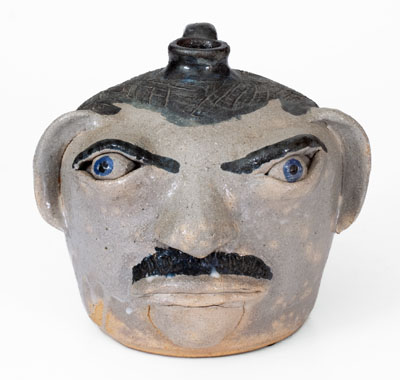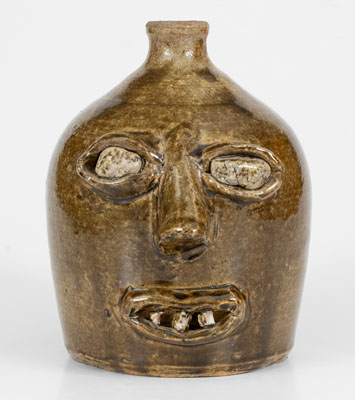Highly Important Alkaline-Glazed Stoneware Presentation Pitcher, Inscribed "PRESENT FOR PLEASANT GROVE / MADE BY J.M. BUSSEL / August 9th 1872," James Madison Bussel, Washington County, GA, 1872, thin-walled, ovoid-bodied pitcher with upswept spout and exceedingly rare double-strap handle with flattened thumb rest; surface profusely decorated from rim to base with incised horizontal banding, around the collar with heavy incised slashes, and throughout with impressed circular, semi-circular, and incised line decoration. Three circular stamps, each composed of different geometric elements--ellipses, small circles, and square-like impressions--are used. A fourth, C-shaped stamp is used in an opposing manner around the bottom half of the pitcher, connected in pairs by long, hand-incised diagonal lines. The pitcher's sculptural handle, composed of a large strap adjoining a smaller strap below, features impressed circular decoration as seen on the base of the collar. The midsection is incised with the large inscription, "PRESENT FOR PLEASANT GROVE / MADE BY J.M. BUSSEL / August 9th 1872." Surface covered in a lustrous light-green alkaline glaze. Outside of the work of David Drake, this recently-surfaced masterpiece is arguably the best example of Southern stoneware to come to auction in years. It was made by mixed-race African-American potter, James Madison Bussel (usually "Bussell" in written histories), as a presentation piece for Pleasant Grove, likely Pleasant Grove Baptist Church, located near Bussel's pottery in Washington County, Georgia. Measuring a relatively large two gallons, the pitcher's stylish potting and decorative treatments create an object of extraordinary artistic value that complements its historical significance. Bussel created the pitcher's dramatically-curved rim by first potting the vessel into a flaring vase and then cutting the collar away after the piece dried to a leather-hard state. The pitcher exhibits some of the thinnest potting that we have seen on a piece of American stoneware. Its wonderful bipartite handle with flattened thumb rest is both decorative as well as functional in the handling and pouring of the vessel, allowing one to tip the pitcher using two hands. The kaleidoscopic array of incising and stamping that blanket the body of the pitcher easily make this work among the most heavily-decorated examples of early Southern stoneware known. Bussel's father, James J. Bussell, was trained in the Washington County, Georgia school of potting--an offshoot of the Edgefield, South Carolina tradition--and was an associate of two other free black potters, Lucius and Elbert Jordan. An eight-gallon wedding jug made by James J. Bussell depicting incised human figures jumping over a broom, an African-American wedding ritual, was famously featured on a 2018 episode of the PBS series, Antiques Roadshow. Interestingly, both the father's wedding jug and the son's church pitcher feature signatures in large, capital-lettered print, boldly identifying each as the object's maker. Of interesting note is a surviving photograph of James M. Bussel (see above). We are aware of only two other photographs of 19th century African-American pottery owners: one of Rich Williams of South Carolina and another of Hiram Wilson of Texas. Combining an over-the-top form, extravagant decoration, and a dated inscription from the maker to the owner, this pitcher serves as both a masterwork of ceramic art as well as a historic "document in clay" symbolic of the Reconstruction Era South. Very nice condition. A 1 1/4" chip to thumb rest. Two spout chips. A small rim chip. A 2 1/2" hairline to right side of rim. A very minor 1" surface line to interior of spout, not visible on exterior. A 1 1/2" hairline from rim on reverse. A horizontal hairline through handle. H 15".






























